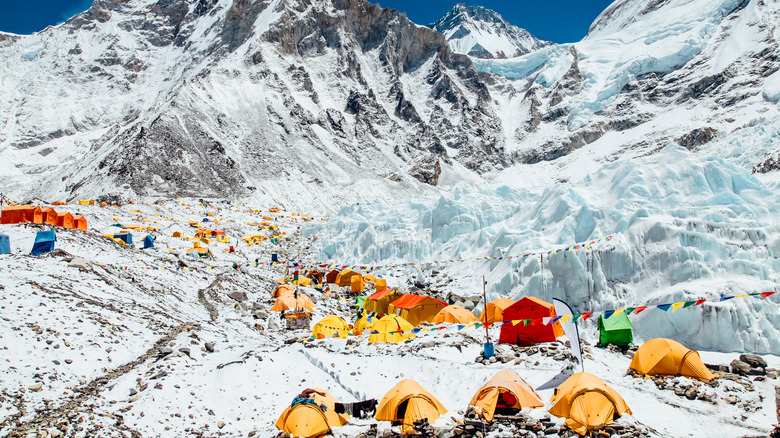Don't Count On Rescuers To Save Your Life In Mount Everest's Macabre 'Rainbow Valley'
Climbing Mount Everest, or even part of it, is one of the most dangerous quests on earth. Not only is it incredibly expensive — at over $60,000 on average — but many don't make it back down. Some parts are notoriously deadlier than others. If you decide to make the trek to these areas and find yourself in a precarious situation, don't count on rescuers to save your life, especially not in Mount Everest's macabrely named "Rainbow Valley."
Mount Everest is divided into different sections, each of which requires a variety of supplies and distinct preparation. Climbers first have to reach base camp, which is 17,595 feet above sea level. While challenging in its own right, this hike is recommended as a trial run before attempting to climb Everest's peak. To reach just the base camp can take 10 days, with stops to acclimate to the lower oxygen levels, which continue to drop the further up you go. Upon reaching base camp, you will spend around five weeks preparing your body for the summit through acclimatization climbs.
In the final push to Everest's summit, hikers will encounter Rainbow Valley. What sounds like a lovely, lush area of the mountain is actually right smack in the middle of the mountain's infamous "death zone" — this covers any part of the mountain above 26,247 feet. While Mount Everest's dangerous weather puts hikers and base camp trekkers in danger, the death zone amps up this risk significantly, posing serious threats to anyone who crosses that threshold. Due to these deadly conditions and the limited amount of room on the path up to the peak, hikers who slip, fall, or just stray from the route could end up as part of Rainbow Valley. Here, those who have died on the mountain remain, along with colorful tents, trash, and oxygen tanks, due to how risky a retrieval mission would be. If you do go off-trail, don't count on rescuers to save your life here.
The unspoken rule of Mount Everest's Rainbow Valley
It's believed that there are currently over 200 bodies on Mount Everest, but the total is likely higher. When anyone decides to climb this mountain, they're taking the risk that while they may reach the top, they may not come back down. Rainbow Valley is a dangerous area in the mountain's death zone, named for the colorful clothing that marks the bodies that remain there. It's extremely morbid, but the nickname caught on because the vibrant winter apparel on the dead makes them look like a multicolored rainbow from a distance. What's worse, those hoping to reach the summit will have to hike over and around those who didn't make it. A fact many may not know about Everest is that there is more than one way to the top, but this path through the Rainbow Valley is the most popular.
What seems callous to those who would never climb Everest is one of the unwritten rules of the mountain: it's extremely dangerous to bring someone else back down or stray off the trail to rescue a fellow hiker. It's common knowledge among climbers that the trail to Everest's peak is littered with those who succumbed to injury, accident, or illness. And sherpas, who take tourist climbers to the top, are in just as much danger as climbers, if not more, given the frequency with which they ascend.
There is no good system in place currently to remove or respectfully bury those who lost their lives and ended up along Rainbow Valley or on Everest in general. Future hikers should know that in this area, you can't expect help to come if something goes wrong. And if Rainbow Valley has put you off attempting to summit, there are alternatives like simply hiking to base camp, which can be a fun hot spring-filled trek that's easier and more affordable than Everest (and probably won't result in a rescue mission).

